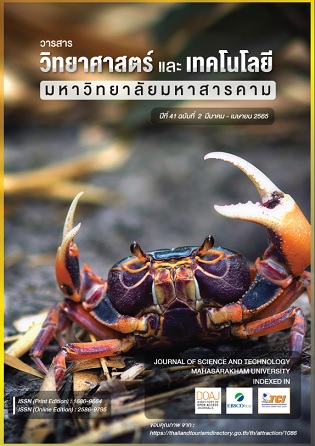Job Shop Scheduling Program with Sand Pile Multi-Objective Genetic Algorithm
Main Article Content
Abstract
This article aims to present job shop scheduling program with sand pile multi-objective genetic algorithm. It is automatic and optimal job scheduling when demand for dynamic production arrives. The original scheduling has changed to job shop scheduling with sand pile multi-objective genetic algorithm to find a new job shop scheduling that is optimization under the conditions of multi-factor.
The results showed that the rate of convergence of sand pile multi-objective genetic algorithm process is higher than non-dominated sorting genetic algorithm II. The measurement of sand pile multi-objective genetic algorithm is more evenly scattered than non-dominated sorting genetic algorithm II.
Article Details
Section
Original Articles
References
Al-Salem, M., Bedoya-Valencia, L., & Rabadi, G. (2016). Heuristic and exact algorithms for the two-machine just in time job shop scheduling problem. Mathematical Problems in Engineering, 5, 1-11. http://dx.doi.org/10. 1155/2016/6591632.
Calis, B., & Bulkan, S. (2015). A research survey: review of AI solution strategies of job shop scheduling problem. Journal of Intelligent Manufacturing, Computing, 26(5), 961-973.
Gupta, A., & Chauhan, S. (2015). A heuristic algorithm for scheduling in a flow shop environment to minimize makespa. International Journal of Industrial Engineering Computations, 6, 173-184.
Johnson, R., & Christensen, L. (2014). Educational research quantitative, qualitative, and mixed approaches (5th ed.). SAGE.
Kalshetty, Y. R., Adamuthe, A. C., & Kumar, S. P. (2020). Genetic algorithms with feasible operators for solving job shop scheduling problem. Journal of Scientific Research, 64 (1), 310-321.
Pongchairerks, P. (2019). A two-level metaheuristic algorithm for the job-shop scheduling problem. Complexity, 2019, 1-11.
Raeesi, M. R. N., & Kobt, Z. (2012). A memetic algorithm for job shop scheduling using a critical-path-based local search heuristic. Memetic Computing, 4(3), 231-245.
Schutze, O., Martin, A., Lara, A., Alvarado, S., Salinas, E., & Coello, C. A. C. (2015). The directed search method for multi-objective memetic algorithms. Computational Optimization and Applications, 63(2), 305-332.
Sonmez, R., & Uysal, F. (2015). Backward-forward hybrid genetic algorithm for resource-constrained multi project scheduling problem. Journal of Computing in Civil Engineering, 29(5), 04014072.
Sotskov, Y. N., Matsveichuk, N. M., & Hatsura, V. D. (2020). Two-machine job-shop scheduling problem to minimize the makespan with uncertain job durations. Algorithms, 13(1), 1-45.
Turkyılmaz, A., Senvar, O., Unal, I., & Bulkan, S. (2020). A research survey: Heuristic approaches for solving multi objective flexible job shop problems. Journal of Intelligent Manufacturing, 31(8), 1949-1983. https://doi.org/10.1007/s10845-020-01547-4
Vakili, M. M., & Jahangiri, N. (2018). Content validity and reliability of the measurement tools in educational, behavioral, and health sciences research. Journal of Medical Education Development, 10(28), 106-119.
Wang, C. L., Rong, G., Weng, W., & Feng, Y. P. (2015). Mining scheduling knowledge for job shop scheduling problem. IFAC-PapersOnLine, 48(3), 800-805.
Calis, B., & Bulkan, S. (2015). A research survey: review of AI solution strategies of job shop scheduling problem. Journal of Intelligent Manufacturing, Computing, 26(5), 961-973.
Gupta, A., & Chauhan, S. (2015). A heuristic algorithm for scheduling in a flow shop environment to minimize makespa. International Journal of Industrial Engineering Computations, 6, 173-184.
Johnson, R., & Christensen, L. (2014). Educational research quantitative, qualitative, and mixed approaches (5th ed.). SAGE.
Kalshetty, Y. R., Adamuthe, A. C., & Kumar, S. P. (2020). Genetic algorithms with feasible operators for solving job shop scheduling problem. Journal of Scientific Research, 64 (1), 310-321.
Pongchairerks, P. (2019). A two-level metaheuristic algorithm for the job-shop scheduling problem. Complexity, 2019, 1-11.
Raeesi, M. R. N., & Kobt, Z. (2012). A memetic algorithm for job shop scheduling using a critical-path-based local search heuristic. Memetic Computing, 4(3), 231-245.
Schutze, O., Martin, A., Lara, A., Alvarado, S., Salinas, E., & Coello, C. A. C. (2015). The directed search method for multi-objective memetic algorithms. Computational Optimization and Applications, 63(2), 305-332.
Sonmez, R., & Uysal, F. (2015). Backward-forward hybrid genetic algorithm for resource-constrained multi project scheduling problem. Journal of Computing in Civil Engineering, 29(5), 04014072.
Sotskov, Y. N., Matsveichuk, N. M., & Hatsura, V. D. (2020). Two-machine job-shop scheduling problem to minimize the makespan with uncertain job durations. Algorithms, 13(1), 1-45.
Turkyılmaz, A., Senvar, O., Unal, I., & Bulkan, S. (2020). A research survey: Heuristic approaches for solving multi objective flexible job shop problems. Journal of Intelligent Manufacturing, 31(8), 1949-1983. https://doi.org/10.1007/s10845-020-01547-4
Vakili, M. M., & Jahangiri, N. (2018). Content validity and reliability of the measurement tools in educational, behavioral, and health sciences research. Journal of Medical Education Development, 10(28), 106-119.
Wang, C. L., Rong, G., Weng, W., & Feng, Y. P. (2015). Mining scheduling knowledge for job shop scheduling problem. IFAC-PapersOnLine, 48(3), 800-805.

